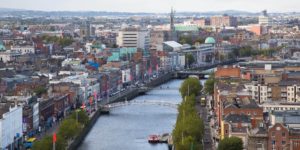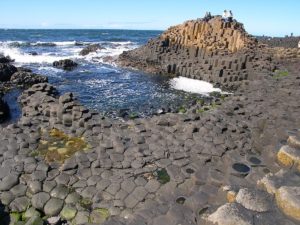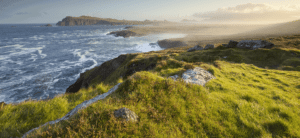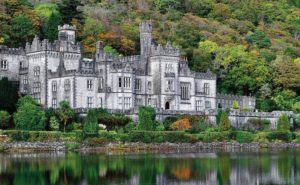ATTRACTIONS
 Dublin Dublin is the capital and largest city of Ireland. It is a populous city whose metropolitan area is home to more than one-fourth of the country’s total population. Dublin is a historical and contemporary center for education, the arts, administration and industry. It has many landmarks and monuments dating back hundreds of years. One of the oldest is Dublin Castle, is a major Irish government complex, conference center, and tourist attraction, the St. Patrick’s is the tallest church (not Cathedral) in Ireland and the largest. The Old Library of Trinity College, holding the Book of Kells (illustrated manuscript), is one of the city’s most visited sites. The Ha’penny Bridge, an iron footbridge over the River Liffey, is one of the most photographed sights in Dublin and considered to be one of Dublin’s most iconic landmarks. Dublin City Council manages over 1,500 hectares of parks. Public parks include the The Phoenix Park is about 3 km west of the city center, north of the River Liffey. Its 16-kilometre perimeter wall encloses 707 hectares, making it one of the largest walled city parks in Europe. It includes large areas of grassland and tree-lined avenues, and home to a herd of fallow deer. The park is also home to Dublin Zoo, Ashtown Castle, and the official residences of the President of Ireland and the United States Ambassador.
Dublin Dublin is the capital and largest city of Ireland. It is a populous city whose metropolitan area is home to more than one-fourth of the country’s total population. Dublin is a historical and contemporary center for education, the arts, administration and industry. It has many landmarks and monuments dating back hundreds of years. One of the oldest is Dublin Castle, is a major Irish government complex, conference center, and tourist attraction, the St. Patrick’s is the tallest church (not Cathedral) in Ireland and the largest. The Old Library of Trinity College, holding the Book of Kells (illustrated manuscript), is one of the city’s most visited sites. The Ha’penny Bridge, an iron footbridge over the River Liffey, is one of the most photographed sights in Dublin and considered to be one of Dublin’s most iconic landmarks. Dublin City Council manages over 1,500 hectares of parks. Public parks include the The Phoenix Park is about 3 km west of the city center, north of the River Liffey. Its 16-kilometre perimeter wall encloses 707 hectares, making it one of the largest walled city parks in Europe. It includes large areas of grassland and tree-lined avenues, and home to a herd of fallow deer. The park is also home to Dublin Zoo, Ashtown Castle, and the official residences of the President of Ireland and the United States Ambassador.
 The Giant’s Causeway is an area of about 40,000 interlocking basalt columns, the result of an ancient volcanic fissure eruption. It is located in County Antrim on the north coast of Northern Ireland. Visitors can walk over the basalt columns at the edge of the sea, a half-mile walk from the entrance to the site. The tops of the columns form stepping stones that lead from the cliff foot and disappear under the sea. Most of the columns are hexagonal, although there are also some with four, five, seven or eight sides. Much of the Giant’s Causeway and Causeway Coast World Heritage Site is today owned and managed by the National Trust and the remainder of the site is owned by the Crown Estate and a number of private landowners. It is one of the most popular tourist attractions in Northern Ireland. Some of the structures in the area, having been subject to several million years of weathering, resemble objects, such as the Organ and Giant’s Boot structures. Other features include many reddish, weathered low columns known as Giant’s Eyes, created by the displacement of basalt boulders; the Shepherd’s Steps; the Honeycomb; the Giant’s Harp; the Chimney Stacks; the Giant’s Gate and the Camel’s Hump. It was declared a World Heritage Site by UNESCO in 1986, and a national nature reserve in 1987 by the Department of the Environment for Northern Ireland. In a 2005 poll of Radio Times readers, the Giant’s Causeway was also named as the fourth greatest natural wonder in the United Kingdom.
The Giant’s Causeway is an area of about 40,000 interlocking basalt columns, the result of an ancient volcanic fissure eruption. It is located in County Antrim on the north coast of Northern Ireland. Visitors can walk over the basalt columns at the edge of the sea, a half-mile walk from the entrance to the site. The tops of the columns form stepping stones that lead from the cliff foot and disappear under the sea. Most of the columns are hexagonal, although there are also some with four, five, seven or eight sides. Much of the Giant’s Causeway and Causeway Coast World Heritage Site is today owned and managed by the National Trust and the remainder of the site is owned by the Crown Estate and a number of private landowners. It is one of the most popular tourist attractions in Northern Ireland. Some of the structures in the area, having been subject to several million years of weathering, resemble objects, such as the Organ and Giant’s Boot structures. Other features include many reddish, weathered low columns known as Giant’s Eyes, created by the displacement of basalt boulders; the Shepherd’s Steps; the Honeycomb; the Giant’s Harp; the Chimney Stacks; the Giant’s Gate and the Camel’s Hump. It was declared a World Heritage Site by UNESCO in 1986, and a national nature reserve in 1987 by the Department of the Environment for Northern Ireland. In a 2005 poll of Radio Times readers, the Giant’s Causeway was also named as the fourth greatest natural wonder in the United Kingdom.
 Cliffs of Moher – County Clare are sea cliffs located at the southwestern edge of the Burren region in County Clare, Ireland. From the cliffs, and from atop the tower, visitors can see the Aran Islands in Galway Bay, the Maumturks and Twelve Pins mountain ranges to the north in County Galway, and Loop Head to the south. The cliffs are one of the most popular tourist destinations in Ireland and topped a list of attractions in 2006 by drawing almost one million visitors; the total number of visits is now around 1.5 million per annum. The Cliffs of Moher are a majestic, remnant of the last ice age. The official Cliffs of Moher Coastal Walk runs for 18 km, from Hag’s Head to Doolin, passing the Visitor Centre and O’Brien’s Tower, with good viewing throughout, subject to rain or sea fog. There are two paths near the visitor center, the official one being set back a little for safety, while an unofficial path runs closer to the edge. You can visit the cliffs especially at sunrise or sunset when you will most likely have the cliffs to yourself. Another nice way of seeing the cliffs is to take a guided walk with a local or the Cliffs of Moher cruise from Doolin, and at certain times fixed-wing aircraft also provide a viewing opportunity.
Cliffs of Moher – County Clare are sea cliffs located at the southwestern edge of the Burren region in County Clare, Ireland. From the cliffs, and from atop the tower, visitors can see the Aran Islands in Galway Bay, the Maumturks and Twelve Pins mountain ranges to the north in County Galway, and Loop Head to the south. The cliffs are one of the most popular tourist destinations in Ireland and topped a list of attractions in 2006 by drawing almost one million visitors; the total number of visits is now around 1.5 million per annum. The Cliffs of Moher are a majestic, remnant of the last ice age. The official Cliffs of Moher Coastal Walk runs for 18 km, from Hag’s Head to Doolin, passing the Visitor Centre and O’Brien’s Tower, with good viewing throughout, subject to rain or sea fog. There are two paths near the visitor center, the official one being set back a little for safety, while an unofficial path runs closer to the edge. You can visit the cliffs especially at sunrise or sunset when you will most likely have the cliffs to yourself. Another nice way of seeing the cliffs is to take a guided walk with a local or the Cliffs of Moher cruise from Doolin, and at certain times fixed-wing aircraft also provide a viewing opportunity.
TRAVEL ADVENTURE
 Ireland is an amazing country with beautiful natural landscapes, picturesque countryside and bustling cities. Landscapes vary from the wild, rugged coastlines to the gently rolling green fields covered with silvery lakes and dark brown bogs of the midlands. 82% of visitors come for that scenery. It is a fantastic place for discovering countryside. From the wild, storm lashed coastlines of the Atlantic Ocean to the tranquil, rolling hills of the Magical Midlands it is a land of surprises. The world-renowned karst limestone region known as the Burren Resplendent was a tropical seabed some 365 million years ago. Dramatic underground caves and watercourses, including the longest stalactite in the Northern hemisphere at Doolin Cave are found here.
Ireland is an amazing country with beautiful natural landscapes, picturesque countryside and bustling cities. Landscapes vary from the wild, rugged coastlines to the gently rolling green fields covered with silvery lakes and dark brown bogs of the midlands. 82% of visitors come for that scenery. It is a fantastic place for discovering countryside. From the wild, storm lashed coastlines of the Atlantic Ocean to the tranquil, rolling hills of the Magical Midlands it is a land of surprises. The world-renowned karst limestone region known as the Burren Resplendent was a tropical seabed some 365 million years ago. Dramatic underground caves and watercourses, including the longest stalactite in the Northern hemisphere at Doolin Cave are found here.  The mountain trail Kerry Way – is Ireland’s longest at 210km and offers fantastic views of the breathtaking landscapes. Spend your days trekking and being engulfed in 10,000 years of Celtic history.
The mountain trail Kerry Way – is Ireland’s longest at 210km and offers fantastic views of the breathtaking landscapes. Spend your days trekking and being engulfed in 10,000 years of Celtic history.
 The hum of traditional Irish music leads us through the ‘Wild West of Ireland’, to the spectacular beauty of Connemara – a cultural region in County Galway. Its silent valleys, pristine fjords, astounding mountains and fairy-tale castles amaze. In the Aran Islands, villages welcome with warm smiles. Hike, bike and kayak your way around Ireland, you’ll experience one of Europe’s oldest cultures. The striking region of Connemara has been a landmark destination for anyone looking for an experience which is beyond the power of description.
The hum of traditional Irish music leads us through the ‘Wild West of Ireland’, to the spectacular beauty of Connemara – a cultural region in County Galway. Its silent valleys, pristine fjords, astounding mountains and fairy-tale castles amaze. In the Aran Islands, villages welcome with warm smiles. Hike, bike and kayak your way around Ireland, you’ll experience one of Europe’s oldest cultures. The striking region of Connemara has been a landmark destination for anyone looking for an experience which is beyond the power of description.
THE PEOPLE
 The Irish are a Celtic nation and ethnic group native to the island, who share a common Irish ancestry, identity and culture. For most of Ireland’s recorded history, the Irish have been primarily a Gaelic people.
The Irish are a Celtic nation and ethnic group native to the island, who share a common Irish ancestry, identity and culture. For most of Ireland’s recorded history, the Irish have been primarily a Gaelic people.
The culture of Ireland includes customs and traditions, language, music, art, literature, folklore, cuisine and sports unique to the area. One example is Saint Patrick’s Day, a cultural and religious celebration held on 17 March.